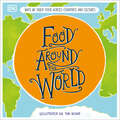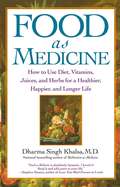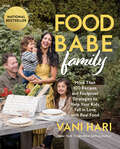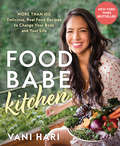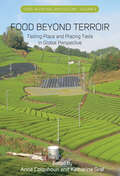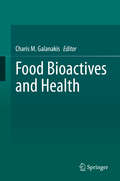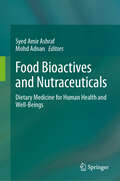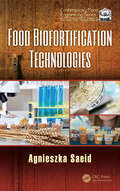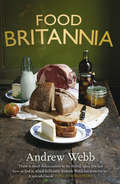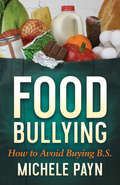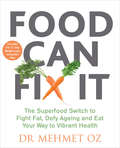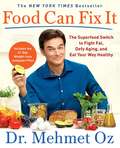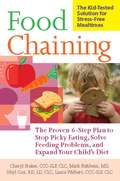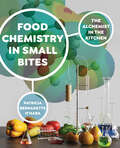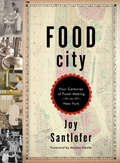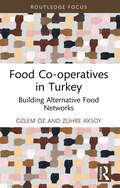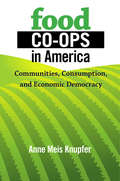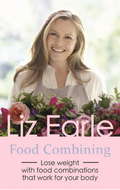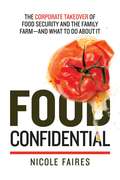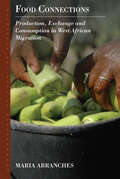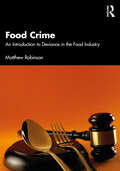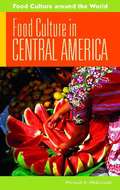- Table View
- List View
Food Around the World (DK Around the World)
by DKIntroduce young readers to a variety of countries and cultures through an exploration of food.Discover fascinating facts about the food on your plate and tasty dishes from all around the world in this educational reader to help children aged 7-9 learn about countries and cultures.Children can explore the significance of food to different cultures and the variety of ways in which food is prepared and shared. Then learn how diet can vary according to personal choice, culture, and medical needs, and how food can be broken down into groups to help us maintain a healthy, balanced diet.The educational series can help children learn about the world, with:Links to key social studies and geography curriculum objectives. Content that allows children to learn about a variety of countries, cultures, and celebrations through food and its significance to each country and culture.Recipes featured that are simple and easy to follow for young readers to try out. Food Around the World follows the journey of food from farm to table, learning how seasons can affect what produce is available. Children can learn how food is packaged, and how to recycle packaging and reduce food waste. Plus, fun food facts show how food can be grown to extremes! About the seriesThis book is part of the …Around the World series, which includes Celebrations Around the World and Language Around the World. The series is designed to inspire and inform children with bright and original illustrations and fascinating facts about the world around us.
Food Around the World: A Cultural Perspective
by Margaret Emeritus McWilliamsFood Around the World: A Cultural Perspective, 4e is a unique and fascinating text examining the geography, history, economic, religious, and cultural factors influencing food consumption and availability. Appropriate for all students, especially those in food science, dietetics, and nutrition, it examines cultural food patterns and fosters an appreciation for various regions, nations, and cuisines. Chapters explore how and why different regions developed their unique cuisines and include recipes from each region. Vivid maps and photographs bring global cultures and foods to life as students travel through each chapter. Extensive learning tools help students master material and make the text an instructor-friendly resource.
Food As Medicine: How to Use Diet, Vitamins, Juices, and Herbs for a
by Guru Dharma KhalsaA holistic approach to healing through making smart food choices by health guru Dr. Dharma Singh Khalsa that combines spiritual advice and integrative medicine to provide healthful recipes and nutrition plans targeting common and chronic illnesses for a longer, healthier, natural life.Did you know that blueberries can increase brain longevity? That kiwi fruit can be an excellent weapon for battling cancer and heart disease? That pears can help prevent fibroid tumors? From the bestselling author of Meditation as Medicine, comes a remarkable book that helps you achieve maximum health by eating well. Grounded in science, Food as Medicine is a pragmatic and accessible reference that sets readers on the right nutritional path. Dr. Khalsa then explains how to use natural organic juices and foods as medicine, and how food can help reverse the progress or diminish the symptoms of certain diseases, such as Alzheimer's and Hepatitis C. Drawing on patient case histories, Food as Medicine outlines the seven principles of "The Khalsa Plan" for healthy eating, details ailment-specific nutritional plans, and lays out dozens of delicious recipes that promote overall well-being. After all, food is not only the original medicine -- it's the best medicine.
Food Babe Family: More Than 100 Recipes and Foolproof Strategies to Help Your Kids Fall in Love with Real Food: A Cookbook
by Vani HariNew York Times best-selling author Vani Hari inspires you with over 100 recipes and everything you need to feed your family in a way that will foster a love for REAL food for life.The multimillion dollar food industry has used their vast resources to target parents, convincing them that it&’s difficult to feed their children good food. But here&’s the truth: parenting is difficult, but feeding your children simple, healthy, real food shouldn&’t be.In Food Babe Family, Vani dispels popular myths about feeding our kids; offers more than 100 delicious recipes that make it simple to put healthy, real food on the table; and helps parents start children on a lifelong path of making good food choices.From Pumpkin Muffins to Taco Salad Cups, Zucchini Pizza Bites, &“Chick-fil-A&” Chicken Nuggets and Waffle Fries, and even Homemade &“Oreos,&” Food Babe Family proves it&’s not only possible, but fun to eat real food without artificial dyes, high fructose corn syrup, and other nasty ingredients.Includes tips and tricks, such as how to:Navigate the food in schools and daycares Deal with "picky eaters"Make mealtime fun for kids, without the processed foodsEat out hassle-free and healthfully at restaurantsAnd more!
Food Babe Kitchen: More than 100 Delicious, Real Food Recipes to Change Your Body and Your Life
by Vani HariNew York Times best-selling author and revolutionary food activist Vani Hari offers an array of quick, easy, REAL food recipes that make cooking fun, healthy, and delicious. This book will inspire you to take control of your health and ditch processed foods for good.Get ready to ditch processed foods for good, and eat the cleanest, healthiest food on the planet!With more than 100 mouthwatering recipes-from Biscuits with Whipped Honey Butter to Baja Fish Tacos, Grapefruit Goddess Salad, Luscious Lemon Bars, and even Homemade Doritos-the Food Babe Kitchen will show readers how delicious and simple it is to eat healthy, easy, real food.Food Babe Kitchen shows you how to shop for the healthiest ingredients by breaking down every aisle in the grocery store with expert label-reading tips and simple swaps, plus a handy meal-planning guide and pantry list to stock your kitchen for success.Eat healthfully, close to the earth, with the best ingredients that you choose, so when you sit down to enjoy a delicious meal you know what you are eating, and you haven't spent all day in the kitchen!Easy-to-follow directions, eye-catching photography, and simple substitutions to accommodate vegan, dairy-free, grain-free, and other diets, make this the ultimate guide to getting back into the kitchen to create healthful meals for yourself and those you love.Getting off processed food has never been easier-or more delicious.
Food Between Friends: A Cookbook
by Jesse Tyler Ferguson Julie TanousBest friends Jesse Tyler Ferguson, star of Modern Family, and recipe developer Julie Tanous pay homage to their hometowns as they whip up modern California food with Southern and Southwestern spins in their debut cookbook. Modern Family star Jesse Tyler Ferguson and chef Julie Tanous love to cook together. They love it so much that they founded a blog, and now put all their favorite recipes into a cookbook for you to dig into with the people you love. In Food Between Friends, they cook up delightful food, spiced with fun stories pulled right from their platonic marriage.Drawing inspiration from the regional foods of the South and Southwest they grew up with, Jesse and Julie put smart twists on childhood favorites, such as Hatch Green Chile Mac and Cheese, Grilled Chicken with Alabama White BBQ Sauce, and Little Grits Soufflés. So come join Jesse and Julie in the kitchen. This book feels just like cooking with a friend—because that&’s exactly what it is.
Food Beyond Terroir: Tasting Place and Placing Taste in Global Perspective (Food, Nutrition, and Culture)
by Katharina Graf Anna ColquhounFrom winemaking in occupied territories to fishing in polluted seas, home cooking in refugee communities, and vegan cheesemaking, this collection explores the complex ways taste and place intersect with political, ecological, social, and economic issues. Through diverse ethnographic case studies, leading food scholars examine the meaning and making of place and taste. In doing so, the book challenges terroir-inspired notions of a fixed taste of place and pushes the boundaries of what we think we know about taste-place relations.
Food Bioactives and Health (Food Bioactive Ingredients Ser.)
by Charis M. GalanakisBioactive natural compounds have gained attention in recent years due to their potential health benefits, including reducing the risk of diabetes, cancer, and cardiovascular diseases. These benefits derive from bioactive compounds' anti-tumor, anti-inflammatory, anti-oxidative, anti-hypertensive and anti-hyperlipidemic activities, which serve in addition to their basic nutritional functions. Over the last decade, researchers have investigated the health impact of bioactive compounds in detail, and the development of food applications has attracted great interest. Consumer demand has surged for functional foods (nutraceuticals), superfoods, and tailor-made foods, generated by supplementing traditional food products with bioactive ingredients. Food Bioactives and Health offers comprehensive coverage of the properties and health effects of food bioactives in view of new trends in processing, food science and food technology. Starting with the metabolic characteristics of polyphenols, glucosinolates, and other food bioactives, the text then dives into their impact on human health and recent applications in the world of food technology. For food scientists, food technologists, and product developers looking to understand the role of food bioactives in health and develop applications in personalized nutrition, functional foods and nutraceuticals, Food Bioactives and Health serves as a one-stop reference.
Food Bioactives and Nutraceuticals: Dietary Medicine for Human Health and Well-Beings
by Mohd Adnan Syed Amir AshrafThis book examines nutraceuticals derived from plant, animal, or microbial sources, and presenting significant opportunities for food scientists and industry professionals to develop innovative foods or food components that address future human wellness and well-being requirements. These nutraceuticals can be specifically identified as antioxidants, dietary fiber, prebiotics, polyunsaturated fatty acids, probiotics, vitamins, polyphenols, and spices. The book also intends to consolidate current research and reviews on bioactive components inherent in traditional foods, highlighting their nutraceutical significance for promoting a healthy lifestyle. Moreover, it elaborates on the potential therapeutic applications of food bioactives as next-generation nutraceuticals sourced from novel origins. Emphasis is placed on various aspects of food bioactive compounds, exploring their prospective roles in the formulation of nutraceuticals aimed at enhancing human health and wellness, while also evaluating their potential in the management and prevention of metabolic disorders. Furthermore, the volume acknowledges the clinical implications of nutraceuticals, including their prospective applications within the food and pharmaceutical industries.
Food Biofortification Technologies (Contemporary Food Engineering)
by Agnieszka SaeidBiofortification, which can be defined as the process of increasing the content/density of essential nutrients and/or its bioavailability of food with valuable compounds, is a promising means of increasing nutrient intakes. Traditional fortification practices in which exogenous nutrients are added to food can increase the content of nutrients but the use of biofortified foods with nutrients also may deliver the compounds in a more available form, as well as boost the overall relative effectiveness of these foods in raising nutrients status. Food Biofortification Technologies presents the state of the art in the field of novel methods of fortification and agricultural treatments as a way to improve the quality of obtained food products or compounds enriched with valuable nutrients. The book deals with fortification methods and agricultural treatments, which can improve the quality of food products or other agricultural compounds, providing them with a higher density of valuable nutrients. The utilization of novel products, such as feed additives and fertilizers, can avert nutrients depletion in food products. The book describes new and conventional methods of introducing valuable compounds into food components and presents the application of biosorption, bioaccumulation, and utilization of fertilizers in obtaining designer food. Attention is paid to the use of biomass as the carrier of nutrients such as microelements into the food components. The chapters are dedicated to specific food products and their nutrient components. The first chapter discusses the agronomic biofortification with micronutrients where the fertilization strategies are pointed out as a key to plant/cereals fortification. Other chapters present the fortification of animal foodstuffs such as meat, fish, milk, and eggs as well as the fortification of plant foodstuffs such as vegetables, fruits, and cereals. The book also explores advances in food fortification with vitamins and co-vitamins, essential minerals, essential fatty and amino acids, phytonutrients, and enzymes.
Food Boats, Ahoy! (Fountas & Pinnell Classroom, Guided Reading)
by Julie RoweNIMAC-sourced textbook. Floating Food. If you're feeling hungry on the water, you might want to hail a food boat. Food boats have been around for a very long time, and today they're more popular than ever.
Food Britannia
by Andrew WebbBritish food has not traditionally been regarded as one of the world's great cuisines, and yet Stilton cheese, Scottish raspberries, Goosnargh duck and Welsh lamb are internationally renowned and celebrated. And then there are all those dishes and recipes that inspire passionate loyalty among the initiated: Whitby lemon buns and banoffi pie, for example; pan haggerty and Henderson's relish. All are as integral a part of the country's landscape as green fields, rolling hills and rocky coastline. In Food Britannia, Andrew Webb travels the country to bring together a treasury of regional dishes, traditional recipes, outstanding ingredients and heroic local producers. He investigates the history of saffron farming in the UK, tastes the first whisky to be produced in Wales for one hundred years, and tracks down the New Forest's foremost expert on wild mushrooms. And along the way, he uncovers some historical surprises about our national cuisine. Did you know, for example, that the method for making clotted cream, that stalwart of the cream tea, was probably introduced from the Middle East? Or that our very own fish and chips may have started life as a Jewish-Portuguese dish? Or that Alfred Bird invented his famous custard powder because his wife couldn't eat eggs?The result is a rich and kaleidoscopic survey of a remarkably vibrant food scene, steeped in history but full of fresh ideas for the future: proof, if proof were needed, that British food has come of age.
Food Bullying: How to Avoid Buying B.S.
by Michele Payn&“A much-needed critique of our national obsession of guilt over food choices…exposes the multi-trillion-dollar marketing and misrepresentation of food.&”—Dr. David Samadi, urologic oncologist and world-renowned robotic surgeon IPPY Award Gold Medal Winner More than 40,000 products can be found in a grocery store—and there&’s a lot of money to be made by those who use misleading marketing to push us into emotion-driven decisions or make us feel like every purchase is a moral or social statement.Food Bullying upends the way you think about food and gives you permission to make eating choices based on your own social, ethical, environmental, and health standards—rather than brand, friend, or Facebook claims. Michele Payn, one of North America&’s leading voices in connecting farm and food, takes a startling look at the misrepresentation of food and sheds light on bogus nutrition and environmental claims to help you recognize and stand up to the bullies. Food Bullying guides you through understanding food label claims and offers insight on &“the hidden world of farming&”. Armed with science and a lifetime on the farm, Michele provides a six-step action plan for you to overcome food bullying, simplify safe food choices, and even save time in the grocery store. &“Engages and enables readers to overcome their fear to make shopping, food preparation and eating enjoyable endeavors rather than a battleground.&”—Leslie Bonci, MPH, RDN, CSSD, LDN, Kansas City Chiefs Sports Dietitian
Food Can Fix It: The Superfood Switch to Fight Fat, Defy Ageing and Eat Your Way to Vibrant Health
by Mehmet OzWhat if you had an effortless way to improve your mood, heal your body, lose weight and feel fantastic? What if a cure for everything from fatigue to stress to chronic pain lay at your fingertips? In his ground-breaking new book, Dr Oz reveals how, with every meal, snack and bite, we hold the solution to our health problems. In a world of endless choices, determining what to eat and when to eat it can seem overwhelming. Fortunately, it doesn't have to be this way. In Food Can Fix It, Dr Oz lays out a simple, easy-to-follow 28-day blueprint for harnessing the healing power of food. Through simple modifications and a meal plan filled with nutrient-rich superfoods, readers will kickstart weight loss, improve their energy, decrease inflammation and prevent or alleviate a host of other common conditions all without medication. Loaded with quick tips on everything from when to pour that first cup of coffee to choosing the right mid-day snack, Food Can Fix It is the ultimate field guide to eating in a modern lifestyle, and the ticket to living your best life, starting today.
Food Can Fix It: The Superfood Switch to Fight Fat, Defy Aging, and Eat Your Way Healthy
by Mehmet OzIncludes the 21-Day Weight Loss Jumpstart! Improve your life through your diet with a friendly, non-punishing, and completely authoritative approach to harnessing the healing power of food from Dr. Mehmet Oz, America’s #1 authority on health and well-being.What if you had an effortless way to improve your mood, heal your body, lose weight, and feel fantastic? What if a cure for everything from fatigue to stress to chronic pain lay at your fingertips? In his groundbreaking new book, Dr. Oz reveals how every meal, snack, and bite we take holds the solution to our health problems. In a world of endless choices, determining what to eat and when to eat it can seem overwhelming. Fortunately, it doesn’t have to be this way. In Food Can Fix It, Dr. Oz lays out a simple, easy-to-follow blueprint for harnessing the healing power of food. Through simple modifications and a meal plan filled with nutrient-rich superfoods, Dr. Oz explains how to kickstart weight loss, improve your energy, decrease inflammation, and prevent or alleviate a host of other common conditions—all without medication. His plan also includes stress-free, healthy, and delicious recipes and appealing full-color photographs that show just how easy it can be to improve your well-being through the food you eat. Drawing on responses from thousands of readers of The Good Life, Dr. Oz's popular, prize-winning magazine, Food Can Fix It is the ultimate guide to eating for health, and the ticket to living your best life, starting today.
Food Chaining: The Proven 6-Step Plan to Stop Picky Eating, Solve Feeding Problems, and Expand Your Child's Diet
by Cheri Fraker Laura Walbert Sibyl Cox Mark Fishbein Shannon Cole BarkerInitially developed by co-author Cheri Fraker in the course of treating an eleven-year-old who ate nothing but peanut butter, bread, and milk, Food Chaining is a breakthrough approach for dealing with picky eating and feeding problems at any age. Food Chaining emphasizes the relationship between foods in regard to taste, temperature, and texture. In Food Chaining, the internationally known feeding team behind this unique method shows how to help your child enjoy new and nutritious foods, no matter what the nature of his picky eating. The guide also includes information on common food allergies, improving eating skills, advice specific to special needs kids, and a pre-chaining program to help prevent food aversions before they develop. Food Chaining will help you raise a lifelong healthy eater.
Food Chemistry in Small Bites: The Alchemist in the Kitchen
by Patricia B O'HaraFood Chemistry in Small Bites takes readers on an up-close scientific journey through the transformation of food when meals are prepared. Organized in bite-size, digestible units, this innovative text introduces students to food's molecular makeup as well as the perception of food by the five senses. Using familiar foods as examples, it explores what happens to ingredients when heated, cooled, or treated and also considers what happens when materials that don’t naturally mix are forced to do so. With informative, full-color renderings and a hands-on lab section, the book encourages students to think like scientists while preparing delicious dishes. Readers will formulate hypotheses as to why certain foods taste hot despite being at room temperature, why milk separates into curds and whey when lemon is added, and other ordinary but chemically complex phenomena. This book also importantly challenges readers to think critically about the future of food in the face of a warming planet.
Food City: Four Centuries of Food-Making in New York
by Marion Nestle Joy SantloferFrom the breweries of New Amsterdam to Brooklyn’s Sweet’n Low, a vibrant account of four centuries of food production in New York City. New York is hailed as one of the world’s “food capitals,” but the history of food-making in the city has been mostly lost. Since the establishment of the first Dutch brewery, the commerce and culture of food enriched New York and promoted its influence on America and the world by driving innovations in machinery and transportation, shaping international trade, and feeding sailors and soldiers at war. Immigrant ingenuity re-created Old World flavors and spawned such familiar brands as Thomas’ English Muffins, Hebrew National, Twizzlers, and Ronzoni macaroni. Food historian Joy Santlofer re-creates the texture of everyday life in a growing metropolis—the sound of stampeding cattle, the smell of burning bone for char, and the taste of novelties such as chocolate-covered matzoh and Chiclets. With an eye-opening focus on bread, sugar, drink, and meat, Food City recovers the fruitful tradition behind today’s local brewers and confectioners, recounting how food shaped a city and a nation.
Food Co-operatives in Turkey: Building Alternative Food Networks (Routledge Focus on Environment and Sustainability)
by Özlem Öz Zühre AksoyThis book addresses the roles played by food co-operatives in the attempt to build alternative food networks, drawing on an in-depth analysis of case studies in Turkey. While many existing studies focus on food co-operatives and alternative food networks in the Global North, this book provides an important insight into a country from the Global South and, in doing so, not only provides a novel perspective but also challenges the rigid North–South categorization. The book provides a rounded view by examining both a producer and a consumer co-operative: BÜKOOP is a university-based consumer food co-operative, and the Vakıflı co-operative is a food-producing co-operative located in the Hatay province on the Mediterranean coast of Turkey. These two co-operatives, which have been working together for more than ten years, share the dream of establishing a network of co-operatives, in which producers exist in solidarity with consumers, blurring the dichotomy of producer versus consumer as well as rural versus urban. In addition to contributing towards a better understanding of the urban–rural divide, within the framework of alternative food networks, the in-depth analysis of these two cases enables us to explore how food co-operatives develop and how they keep their commitment to their original goals and ideals so as to help build an alternative food system. The lessons we learn from these two working case examples highlight the successes and areas of improvement for food co-operatives. They also provide evidence against the pessimism about alternative food networks by demonstrating that co-operatives can democratize both production and consumption. This book will be of interest to students and scholars studying alternative food networks, food justice, food sovereignty, transformation towards sustainable food systems, social movements, and the urban–rural divide.
Food Co-ops In America
by Anne Meis KnupferIn recent years, American shoppers have become more conscious of their food choices and have increasingly turned to CSAs, farmers' markets, organic foods in supermarkets, and to joining and forming new food co-ops. In fact, food co-ops have been a viable food source, as well as a means of collective and democratic ownership, for nearly 180 years. In Food Co-ops in America, Anne Meis Knupfer examines the economic and democratic ideals of food cooperatives. She shows readers what the histories of food co-ops can tell us about our rights as consumers, how we can practice democracy and community, and how we might do business differently. In the first history of food co-ops in the United States, Knupfer draws on newsletters, correspondence, newspaper coverage, and board meeting minutes, as well as visits to food co-ops around the country, where she listened to managers, board members, workers, and members. What possibilities for change—be they economic, political, environmental or social—might food co-ops offer to their members, communities, and the globalized world? Food co-ops have long advocated for consumer legislation, accurate product labeling, and environmental protection. Food co-ops have many constituents—members, workers, board members, local and even global producers—making the process of collective decision-making complex and often difficult. Even so, food co-ops offer us a viable alternative to corporate capitalism. In recent years, committed co-ops have expanded their social vision to improve access to healthy food for all by helping to establish food co-ops in poorer communities.
Food Combining: Lose Weight with Food Combinations that Work for Your Body (Wellbeing Quick Guides)
by Liz EarleLiz Earle explains the science behind food combining and shows you how smart combinations can improve digestion and nutrition, promote weight loss and help you to feel great.Bestselling beauty and wellbeing writer Liz Earle's fully revised and updated quick guide to the principles of food combining, including:- The science behind food combining and how separating protein and carbohydrates can improve digestion and boost weight loss- A guide to the food groups, including information about acid and alkaline-forming foods- Tips and advice on how to incorporate the principles of food combining into your everyday life - Delicious recipes including Lemon Chicken, Prawn Kebabs with Herb Dressing, and Spiced Bananas
Food Confidential: The Corporate Takeover of Food Security and the Family Farm?and What to Do About It
by Nicole FairesFight the power and protect your family from the corporate interests that control our food chain. When author and homesteader Nicole Faires decided to retrofit an old school bus and tour America’s small farms with her husband and two small children, she expected to learn a lot, be inspired, and have some fun. But what she found disturbed her. Mismanaged small farms; clueless urbanites setting up shop to "get back to the land”; a mindless devotion to organic farming; and, ultimately, the discovery of just how dependent we are on corporations for our food. She began to understand how dangerous and fragile our food system really is. Climate change. Farmers retiring or going out of business. Corporations controlling our food distribution system while being protected from the consequences when they endanger our health. Skyrocketing food prices. Outsourced food production. With this admittedly bleak assessment of the current state of affairs, Nicole and her family decided to abandon the bus trip and instead start a farm. "I couldn’t tell people the solutions to our food crisis while I was traipsing around America taking photos. I had to live it,” Nicole says. And so the seeds for Food Confidential were sown. Our basic right to healthy food is at risk. What can we do? Written in an astute, engaging style, armed with examples from her own homesteading lifestyle, small farmer Nicole Faires’s Food Confidential gives you the tools to fight the intangible battles, as well as the practical ones.
Food Connections: Production, Exchange and Consumption in West African Migration (Anthropology of Food & Nutrition #10)
by Maria AbranchesFood Connections follows the movement of food from its production sites in West Africa to its final spaces of consumption in Europe. It is an ethnographic study of economic and social life amongst a close-knit community of food producers, traders and consumers and a wide range of small intermediaries that operate in Guinea-Bissau and Portugal. By investigating the way meanings of food and land are embedded in everyday experiences and relationships in the various phases of the movement, on both sides of the migration, it reveals the connections that transnational processes of food production, exchange and consumption generate between two lifeworlds.
Food Crime: An Introduction to Deviance in the Food Industry
by Matthew RobinsonThis book addresses the various forms of deviance and criminality found within the conventional food system. This system—made up of numerous producers, processors, distributors, and retailers of food—has significant, far-reaching consequences bearing upon the environment and society.Food Crime broadly outlines the processes and impacts of this food system most relevant for the academic discipline of criminology, with a focus on the negative health outcomes of the US diet (e.g., obesity and diabetes) and negative outcomes associated with the system itself (e.g., environmental degradation). The author introduces the concept of "food criminology," a new branch of criminology dedicated to the study of deviance in the food industry. Demonstrating the deviance and criminality involved in many parts of the conventional food system, this book is the first to provide exhaustive coverage of the major issues related to what can be considered food crime. Embedded in the context of state-corporate criminality, the concepts and practices exposed in this book bring attention to harms associated with the conventional food system and illustrate the degree of culpability of food companies and government agencies for these harms.This book is of interest to students, scholars, and practitioners seeking a more just and healthy food system and encourages further future research into food crimes in the disciplines of criminology, criminal justice, and sociology.
Food Culture In Central America
by Michael McdonaldFor high school students and general readers, McDonald (anthropology, Florida Gulf Coast U.) describes the food culture of Central America, with discussion of the region's history, geography, and climate, major foods and ingredients, cooking techniques, typical meals and cuisine in specific areas, eating out, special occasions and festivals, and diet and health, including malnutrition, hunger, anemia, obesity, and food aid programs. Recipes are included. Annotation ©2009 Book News, Inc., Portland, OR (booknews.com)
